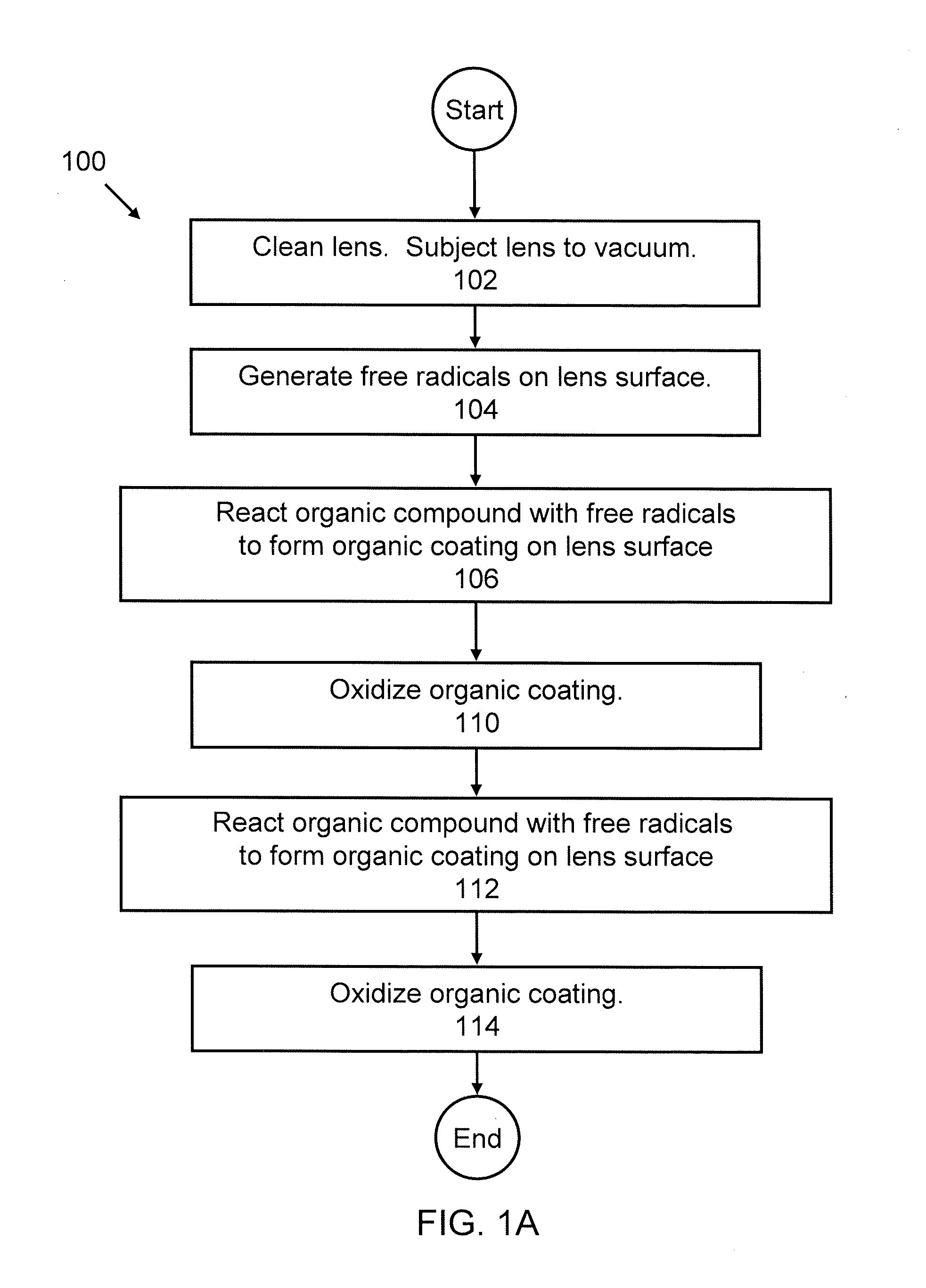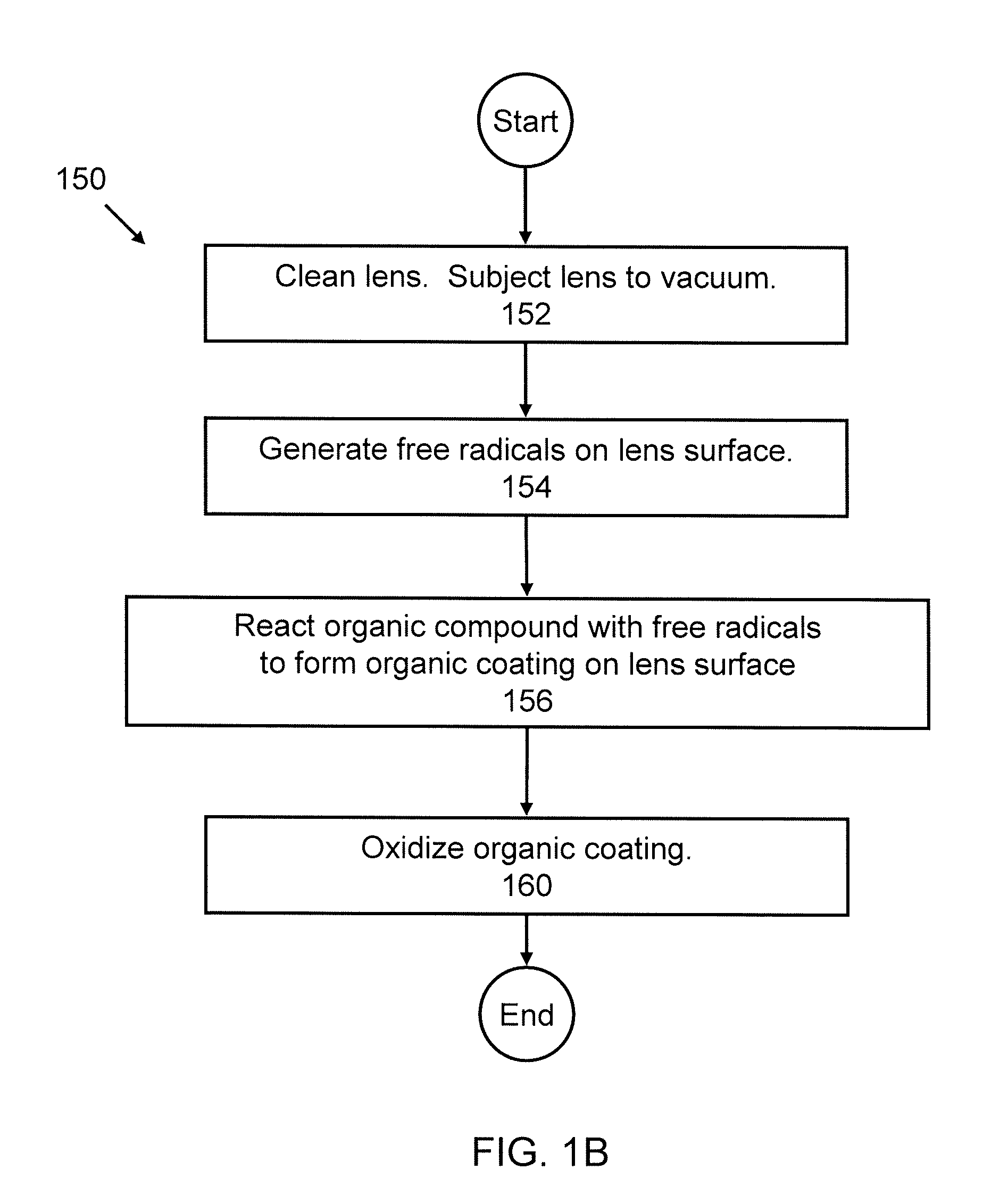Surface Modification of Contact Lenses
a contact lens and surface technology, applied in the field of surface modification of contact lenses, can solve the problems of causing discomfort for patients wearing the lens, and the surface of the lens may be relatively wet, and achieve the effect of higher contact angle and higher contact angl
- Summary
- Abstract
- Description
- Claims
- Application Information
AI Technical Summary
Benefits of technology
Problems solved by technology
Method used
Image
Examples
example 1
Effect of Processing Parameters on Contact Angle
[0052]To establish the effects of selected processing parameters on the wetability of contact lenses subjected to embodiments of the surface modification processes discussed herein, a series of samples were prepared under varying processing conditions. The selected processing parameters included: plasma activation time, oxygen versus nitrogen plasma oxidation, flow rate and pressure of organic compound (methanol), deposition time, oxidation time, and pulse versus continuous oxidation.
[0053]Discs of hard and soft contact lens materials were employed in this study. The hard disc materials comprised RGP material, while the soft disc materials comprised silicone hydrogel. The discs were coated in a horizontal, two-step coating process. Contact angle measurements were performed according to ANSI AZ80.20-2004 using the sisal method with a Goniometer manufactured by KSV and equipped with Cam 100 Optical Contact Angle Meter. The measured conta...
example 2
Effect of Single- and Two-Step Deposition Processes on Contact Angle
[0060]To investigate the effects of contact lens orientation on the resultant contact angle during surface modification, soft discs, hard discs, and hybrid lenses were examined in single-step and two-step coating processes, and contact angle of the discs was measured in dry and hydrated conditions. The single-step coating processes included horizontal concave up, horizontal concave down, and vertical, while the two-step processes included coating horizontally both concave up and concave down. The results of these coating operations are illustrated below in Tables 7-8.
TABLE 7Contact Angle as a Function of Horizontal Coating ProcessConcave UpConcave DownDouble CoatedBeforeAfter Plasma,After Plasma,After Plasma,After Plasma,After Plasma,After Plasma,ConditionTreatment (°)Dry (°)Hydrated, (°)Dry (°)Hydrated (°)Dry (°)Hydrated (°)Hard Disc102.79 ± 6.1622.15 ± 2.6234.93 ± 3.6130.88 ± 3.2733.79 ± 2.9819.29 ± 3.5735.31 ± 5....
example 3
Effect of Wear on Wetability of Contact Lenses Coated in Single- and Two-Step Processes
[0065]Soft discs, hard discs, and hybrid contact lenses were each subjected to the methanol coating process discussed above in Example 1 in both the single- and two-step horizontal coating processes to examine the effects of wear on wetability. To simulate the coating consistency and coherence during wet wear, the discs and lenses were subjected to a total of about 180 rubbing cycles. The hard discs, soft discs, or hybrid lens were placed in palm of hand and drop of saline or lens cleaning solution, such as the formulations available commercially under the trade names Opti Free Express or Acquify, was poured on the subject and unidirectional rubbing was applied for 10 times, then the subject was flipped and same process was repeated on the other side. This procedure was adapted based on regular cleaning of contact lenses after dispensing and storing in lens cleaning solution which has been recomme...
PUM
| Property | Measurement | Unit |
|---|---|---|
| exposure time | aaaaa | aaaaa |
| contact angle | aaaaa | aaaaa |
| power | aaaaa | aaaaa |
Abstract
Description
Claims
Application Information
 Login to View More
Login to View More - R&D
- Intellectual Property
- Life Sciences
- Materials
- Tech Scout
- Unparalleled Data Quality
- Higher Quality Content
- 60% Fewer Hallucinations
Browse by: Latest US Patents, China's latest patents, Technical Efficacy Thesaurus, Application Domain, Technology Topic, Popular Technical Reports.
© 2025 PatSnap. All rights reserved.Legal|Privacy policy|Modern Slavery Act Transparency Statement|Sitemap|About US| Contact US: help@patsnap.com



